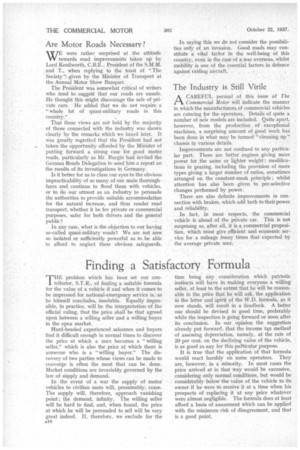Finding a Satisfactory Formula
Page 52

If you've noticed an error in this article please click here to report it so we can fix it.
THE problem which has been set our contributor, S.T.R., of finding a suitable formula for the value of a vehicle if and when it comes to be impressed for national-emergency service is; as he himself concludes, insoluble. Equally impossible, in practice, will be the interpretation of the official ruling, that the price shall be that agreed upon between a willing seller and a willing buyer in the open market.
Hard-headed experienced salesmen and buyers find it difficult enough in normal times to discover the price at which a man becomes a " willing seller," which is also the price at which there is someone who is a "willing buyer." The discovery of two parties whose views can be made to converge is often the most that can be. done. Market conditions are invariably governed by the law of supply and demand.
In the event of a war the supply of motor vehicles to civilian users will, presumably, cease. The supply will, therefore, approach vanishing point ; the demand, infinity. The willing seller will be hard to find, and, when found, the price at which he will be persuaded to sell will be very• great indeed. If, therefore, we exclude for the time being any consideration which patriotic instincts will have in making everyone a willing seller, at least to the extent that he will be reasonable in the price that he will ask, the application in the letter and spirit of the W.D. formula, as it now stands, will result in a deadlock. A better one should be devised in good time, preferably while the inspection is going fonvard or soon after its conclusion. In our opinion the suggestion already put forward, that the income ta,x method of assessing depreciation, namely, at the rate of 20 per cent. on the declining value of the vehicle, is as good as any for this particular purpose.
It is true that the application of that formula would react .harshly on some operators. They are, however, in a minority. In most cases the price arrived at in that way would be excessive, considering only normal conditions, but would be considerably below the value of the vehicle to its owner if he were to receive it at a time when his prospects of replacing it at any price whatever were almost negligible. The formula does at least afford a basis of assessment which can be applied with the minimum risk of disagreement, and that is a good point.
























































































































